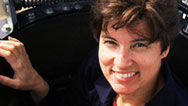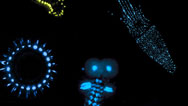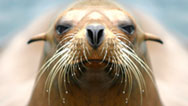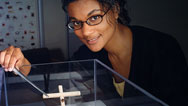Profile: Edith Widder
- Posted 07.23.08
- NOVA scienceNOW
Go for a deep-sea dive with a marine biologist who is seeing things never before recorded on the ocean floor. Edie Widder studies marine bioluminescence, the biochemical emission of light by ocean animals. Bioluminescent animals can light up the murky depths, and Widder is doing some lighting of her own with an innovative camera system called the "Eye in the Sea." It uses a wavelength of light invisible to sea creatures to catch them unawares.
Widder's research and innovation of new technologies have won her a MacArthur "genius" grant, which will help support her work at the Ocean Research and Conservation Association, an organization she cofounded. Her passion for studying marine life is matched by her drive to help ensure its conservation and the health of marine ecosystems worldwide.
Transcript
PROFILE: EDITH WIDDER
PBS Airdate: July 23, 2008
NEIL DeGRASSE TYSON: The bottom of the ocean is a dark and secretive place. But if you come down here to take a look around, once you turn on a light, of course, all the interesting stuff disappears.
Well, in this episode's profile, we'll meet one of the world's most determined undersea spies, who's engineering new and ingenious ways to behold the mysteries of the deep.
She's clearly a woman on the go. And when her feet are not firmly on the ground, she's perfecting her sea legs out here.
Edie Widder is a marine biologist and explorer. Her quest? To understand ocean creatures and help save their undersea world.
EDIE WIDDER: I think I have the best job in the world. Seventy-one percent of the planet is covered by water, we've explored less than five percent of the ocean, and there are so many fabulous discoveries that have yet to be made.
NEIL DeGRASSE TYSON: She's working on discovering how animals communicate using light. It's called bioluminescence.
EDIE WIDDER: They use it to attract food, to ward off predators, to attract mates. It's vital to their existence.
NEIL DeGRASSE TYSON: But there's a problem. There are only two ways to study these creatures, in their environment or in ours. Both have their limitations. Bringing them up, well, they're not exactly themselves. Going to them in a submersible also has its drawbacks.
SOeNKE JOHNSEN: It's got lights flashing, motors whirring. And then you come up to some animal, five inches away, and say, you know, "Act natural." And it's not going to happen.
NEIL DeGRASSE TYSON: So Edie came up with a new kind of camera she calls the "Eye in the Sea." It's basically a highly sensitive waterproof security camera on a timer. Its lights are red, which most underwater creatures cannot see.
To entice animals in front of the camera, Edie uses smelly fish guts inside a bait box and an electronic light show that mimics the way certain animals attract prey.
PETER GIRGUIS (Harvard University): There is no doubt that Edie is at the forefront of her field. And this is, again, sort of a tribute to her capacity as a scientist and, let's say, her closet engineering tendencies.
NEIL DeGRASSE TYSON: The Eye gets dropped off on the ocean floor, via submersible. Today, Edie is deploying it in the Bahamas.
EDIE WIDDER: So we're just looking for a nice flat piece of terrain that we can set it down on safely.
PHIL: Topside, our depth is 1,585, one, five, eight, five feet. We're going to attempt to deploy it here.
EDIE WIDDER: Now, you've got to let go at the right moment.
NEIL DeGRASSE TYSON: New revelations pop up every time Edie uses it.
EDIE WIDDER: The payoffs have been huge. I mean, every time we put this thing down, we see something nobody's ever seen before.
NEIL DeGRASSE TYSON: In the Gulf of Mexico, the Eye recorded an amazing first: a squid, over six feet long, that is so new to science, it cannot be placed in any known family.
EDIE WIDDER: I screamed so loud; and I'm not a screamer. But I was just wild. I couldn't believe it.
NEIL DeGRASSE TYSON: Most recently, the Eye revealed previously unknown feeding behavior of six-gilled sharks.
EDIE WIDDER: They were doing something nobody's ever seen before. They were rooting on the bottom and apparently sucking up, in the sand, these little pill bugs, these isopods. And it's a possible explanation for how these behemoths survive in what seems like a desert sometimes.
NEIL DeGRASSE TYSON: The Eye has allowed marine biologists to study creatures only a mother could love, or a human like Edie. She's been drawn to other species since she was a kid.
EDIE WIDDER: I loved anything to do with animals from a very early age.
NEIL DeGRASSE TYSON: School, on the other hand, wasn't quite as much fun.
EDIE WIDDER: I was so bored that I just tuned out everything that was being said.
NEIL DeGRASSE TYSON: Then Edie got a new lease on learning. Her parents, both mathematics professors, whisked her away on a magical globetrotting adventure. First stop: Europe.
EDIE WIDDER: ...went to all these magnificent art museums, and I decided I wanted to be an artist. Then we went to Egypt, and I decided I wanted to be an archeologist. And then we went to Australia and saw all of these fabulous animals, and I decided I had to be a biologist.
NEIL DeGRASSE TYSON: One of the last stops? A fateful trip to the teeming reefs in Fiji.
EDIE WIDDER: I just was mesmerized by all of this life everywhere I looked. And so I wanted to be a marine biologist.
NEIL DeGRASSE TYSON: Edie had found her element.
EDIE WIDDER: So the family joke is, "If we'd gone from west to east instead of east to west, would I have ended up as an artist?" But I think the total lack of talent might have been somewhat of a drawback.
NEIL DeGRASSE TYSON: And then she found a soul mate. She was in high school, when she caught husband Dave's eye.
DAVE SMITH (Edie Widder's Husband): There was an assembly, and I was sitting in there, and I saw her come down the aisle with some of her girlfriends. And she was wearing a leather skirt. And she just looked really hot. She was definitely fantasy stuff.
EDIE WIDDER: I think the leather skirt is a figment of his imagination. But, okay, we'll keep it in the mythology.
But he was a boy with a brain. He was the first one I'd ever met. Then one of my girlfriends pointed out to me, "Wow, he's got great shoulders." Shoulders? Really? And so we started dating. And I hate to admit it, but I married the first boy I ever dated.
NEIL DeGRASSE TYSON: And they lived happily ever after...well, almost.
EDIE WIDDER: It turns out my poor husband gets seasick if there's a heavy dew on the lawn. In fact, he has declared he will never be going to sea with me again.
NEIL DeGRASSE TYSON: That's okay. There's lots for him to do on land. Dave's an expert in high tech instruments and is pitching in with Edie's newly-founded Ocean Research & Conservation Association, ORCA.
EDIE WIDDER: You were talking about storm water runoff. You have to have that meteorological data.
A lot of what we want to do with our new organization is make people aware of the value of the ocean for our existence on this planet.
NEIL DeGRASSE TYSON: To do this, Edie came up with another invention she calls Kilroy. It's a monitoring device equipped with sensors that can track salinity, temperature, wave height, direction and speed of the current.
EDIE WIDDER: We can send out commands to it as well as receive information from it.
NEIL DeGRASSE TYSON: To send the data back to shore, Kilroy just makes a call, via standard cell phone technology. They'll keep adding sensors, including some that will measure certain pollutants.
EDIE WIDDER: And suddenly, now, we're starting to understand what's going on. So it's not just this placid blue surface that...everything looks fine. We can start telling people what's really happening.
NEIL DeGRASSE TYSON: Edie is diving into anything that will help people understand the oceans, including a children's book series on bioluminescence.
The originality of her work and her determination to share it with the public have earned her the prestigious MacArthur award.
EDIE WIDDER: I never, ever would have imagined the kind of career I've had. It just wouldn't have occurred to me that anything like this could have been possible. I didn't have any such aspirations. And I still can't believe my good fortune.
Credits
Profile: Edith Widder
- Edited by
- Jonathan Robinson
- Produced and Directed by
- Dana Rae Warren
NOVA scienceNOW
- Executive Producer
- Samuel Fine
- Executive Editor
- Neil deGrasse Tyson
- Senior Series Producer
- Vincent Liota
- Supervising Producers
- Stephen
Sweigart
Joey David - Editorial Producer
- Julia Cort
- Development Producer
- Vinita Mehta
- Senior Editor
- David Chmura
- Online Editor
- Laura Raimondo
- Series Production Assistant
- Fran Laks
- Assistant Editors
- Susan Perla
Tung-Jen (Sunny) Chiang - Compositors
- Brian Edgerton
Yunsik Noh - Music
- Rob Morsberger
- NOVA scienceNOW series animation
- Edgeworx
- Associate Producers
- Melanie
Cunningham
Heeth Grantham
Joan Johnson
Molly Longstreth
Anthony Manupelli
Corey Norman - Camera
- John Baynard
James Callanan
Brian Dowley
Mike Elwell
Tom Fahey
Sean Glenn - Sound Recordists
- Brad Berghom
Clint Bramesco
John Cameron
Tom Eichler
Bill Stefanacci
Dick Williams - Sound Mix
- David Chmura
- Animation
- Eyeball
Carlo Flores
Anthony Kraus, Noisy Neighbor Productions
Zaldy Serrano - Production Assistants
-
Jared Flynn
Elizabeth Stachow
Robin Wiesner - For Lone Wolf Documentary Group
- Executive Producer
- Kirk Wolfinger
- Production Manager
- Donna Huttemann
- For Public Broadcasting for Northern California, KQED
- Executive producer
- Sue Ellen McCann
- Business Manager
- Sandy Schonning
- Archival Material
- California High Speed Rail Authority
Corbis
Mary Evans / Photo Researchers, Inc.
Ship and submersible footage courtesy of Harbor Branch Oceanographic Institute
NASA / STScI
Newlands and Company, Inc.
Orion Treasury Project Team
Orwell Astronomical Society (OASI)
SETI Institute
University of Alabama at Birmingham Department of Pathology PEIR Digital Library
U.S. National Library of Medicine
Edie Widder
Nikica Zaninovic, Richard Bodine, Roger Gosden, Zev Rosenwaks, Lucinda Veeck Gosden at the Center for Reproductive Medicine and Infertility
Embryology Laboratory, Weill Cornell Medical College, New York. - Special Thanks
-
American Museum of Natural History
Beth Israel Deaconess Medical Center
Harbor Branch Oceanographic Institute
Christy Herren
Tom Kilsdonk, SETI Institute
Kevin Langton
John Lewis
Larry Madin
Illustrator Janeen Mason
Michael Nank
Chris Neller, SETI Institute
The ORCA Team
Karen Randall, SETI Institute
Brad Seibel
Yankee - Neil deGrasse Tyson
- is director of the Hayden Planetarium in the Rose Center for Earth and Space at the American Museum of Natural History.
- NOVA scienceNOW Consortium Stations
- Nebraska
Educational Telecommunications, NET
Public Broadcasting for Northern California, KQED
Twin Cities Public Television, TPT
Wisconsin Public Television, WPT - NOVA Series Graphics
- yU + co.
- NOVA Theme Music
- Walter Werzowa
John Luker
Musikvergnuegen, Inc. - Additional NOVA Theme Music
- Ray Loring
Rob Morsberger - Post Production Online Editor
- Spencer Gentry
- Closed Captioning
- The Caption Center
- Publicity
- Carole McFall
Eileen Campion
Lindsay de la Rigaudiere
Victoria Louie
Kate Becker - Senior researcher
- Gaia Remerowski
- Production Coordinator
- Linda Callahan
- Paralegals
-
Raphael Nemes
Sarah Erlandson - Talent Relations
- Scott Kardel, Esq.
Janice Flood - Legal Counsel
- Susan Rosen
- Post Production Assistant
- Darcy Forlenza
- Associate Producer, Post Production
- Patrick Carey
- Post Production Supervisor
- Regina O'Toole
- Post Production Editors
-
Rebecca Nieto
Alex Kreuter - Post Production Manager
- Nathan Gunner
- Compliance Manager
- Linzy Emery
- Development Producer
- Pamela Rosenstein
- Business Manager
- Joseph P. Tracy
- Senior Producer and Project Director
- Lisa Mirowitz
- Coordinating Producer
- Laurie Cahalane
- Senior Science Editor
- Evan Hadingham
- Senior Series Producer
- Melanie Wallace
- Managing Director
- Alan Ritsko
- Senior Executive Producer
- Paula S. Apsell
This material is based upon work supported by the National Science Foundation under Grant No. 0638931. Any opinions, findings, and conclusions or recommendations expressed in this material are those of the author(s) and do not necessarily reflect the views of the National Science Foundation
NOVA scienceNOW is a trademark of the WGBH Educational Foundation
NOVA scienceNOW is produced for WGBH/Boston by NOVA
- Image credit: (Edie Widder) Courtesy Edie Widder
All rights reserved
Participants
- Peter Girguis
- Marine Biologist www.oeb.harvard.edu/faculty/girguis/girguis-oeb.html
- Sonke Johnsen
- Marine Biologist, Duke University www.biology.duke.edu/johnsenlab/people/sjohnsen.html
- Dave Smith
- Widder's husband, Computer Engineer
- Edith Widder
- Biologist and Deep-Sea Explorer
Related Links
-

Edith Widder: Expert Q&A
Marine biologist Edie Widder answers questions about deep-sea exploration and how to protect our endangered oceans.
-

Glowing in the Dark
See a menagerie of bizarre ocean organisms that use bioluminescent light to lure prey, mate, and more.
-

The Secret Life of Judy Lee
Judy Lee designs and engineers all kinds of consumer products. Outside of her day job, she hosts a TV show for kids.
-

Smart Marine Mammals
Marine mammals are wowing researchers with more than just circus tricks.
-

Profile: Maydianne Andrade
By peering into the sex lives of spiders, this evolutionary biologist has shown the upside of cannibalism.



